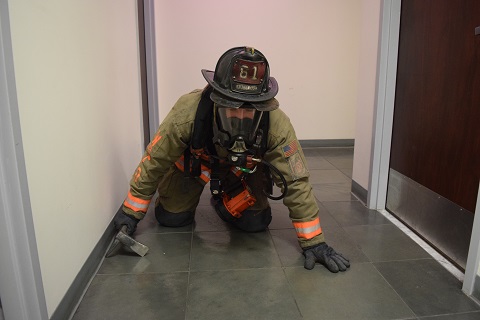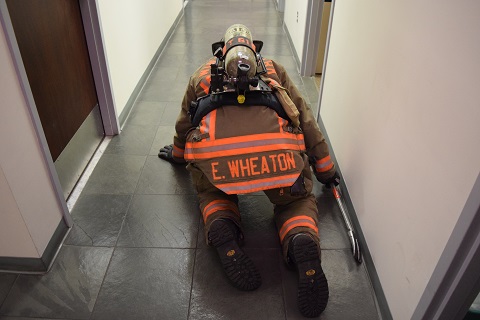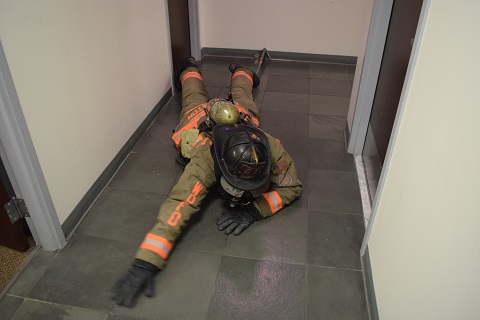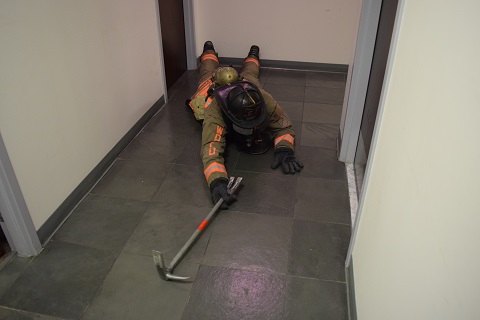Searching with a tool is something that every firefighter needs to be proficient in. Unfortunately, like many of the essential fireground skills we must master, most fire schools do not teach real world search techniques. In particular, they don’t cover how to effectively search with a tool. One of the things we must consider when sweeping with the tool is that the tool has no feeling. It transmits to the firefighter the sensation of coming in contact with an object, but it gives no indication of what the object really is. This forces the firefighter to reach out further, potentially coming off of the wall, to verify what the tool struck. Besides the fact that this takes additional time, it could also cause significant, if not fatal damage to the very victim we are trying to save. A simple drill to illustrate this point would be to search for a large piece of fruit (watermelon, cantaloupe, etc.) Perform this search blacked out, swinging a tool as you search. As you can imagine, you will certainly find the melon, but more than likely speared it or beat it up in the process. It could be argued that sweeping with the non-working end of the tool may minimize the damage to the victim (or melon) but perhaps there is a better way.
Lets start off with discussing which hand you carry the tool in when you search. for this method it is best to carry the tool in the hand of the direction of the search pattern. Left hand search pattern = carry tool in left hand, right hand search pattern = carry the tool in your right hand. This places the tool against the wall, and minimizes the desire to swing and sweep into the room with the tool. When the searching firefighter feels the need to “extend” the search and sweep out into the room , the tool is paced against the wall and the firefighter places their foot on the tool.
As you can see from the pictures below, the firefighters reach into the room is the exact same regardless if the foot was on the wall and tool swept into the room or if the tool was placed on the wall and the firefighter stretched out into the room.
Another thing worth mentioning is that simple act of constantly swinging the tool out into the room actually contributes to firefight fatigue. It takes more energy to swing the tool back and forth than it would to just crawl with it.
Like everything else in the fire service, there is a time and a place were certain techniques should be used over another. This technique may or may not work well for you, but you will only know that after you take the time to train with it. Just keep in mind, when performing a search, you are looking for a viable human life in a very time sensitive manner. It is our duty to master the skill of the search and be able to complete the search in the most time sensitive (and least fatal way) possible.
In our next post we will build on this concept an show some additional things we should consider when performing this type of search.





Searching with your hand is fine if your certain there are no unknown holes or level changes in the area being searched. Doing it with a tool gives a little more distance between a firefighter and a possible injury. The main thing taught to us in ff1 and ff2 is OUR safty first. We are no good for fire services if we get injured…
Here’s the whole thing with FF1 and 2….Forget everything you learned in FF 1 and 2.
I agree with DMAN72 they teach you in FF1 and 2 just the basics when you get out and get a job then the real training begins with the crew you work with. Things to remember this job is always changing what works for you may not work for your partner or crew. keep an open mind and train and listen to the FF’s who have been on the job pick there brain cause when they retire the information is gone with them.
If one’s advice is to forget academy training then you probably went to a lousy academy or…
There should be more than one right way to do anything so that we can adapt to a specific situation. The outstretched tool technique takes skill and practice while the reach of the tool can keep the firefighter out of the jack pot. A hand on the wall allows the firefighter to detect windows just in case we need to get out fast or, of course rescue a victim.
Since I’ve been out stretching the tool for almost 3 decades I think it’s a proven technique.
Use the method that works best.
While I like this method and think it has merit, I’ve also known many a firefighter that, while searching, also use the tool to sound the floor ahead of them – which has ended up likely saving their lives a few times. Spongy floors and holes were detected with the tool prior to the firefighter’s body finding them.
I think you can accomplish both, but I would suggest using that tool in your “wall” hand to continue to sound the floor ahead of you as you search. This is a little uncoordinated and will take practice – just like the rest of our skills. I never felt like searching with the tool, especially the Halligan, was very effective in finding a soft victim.